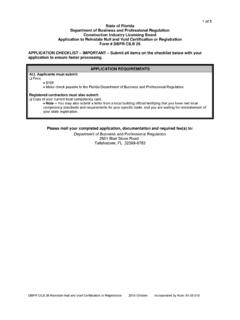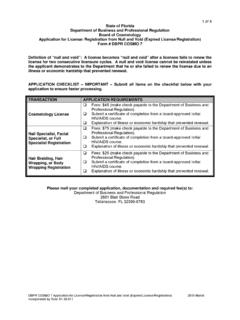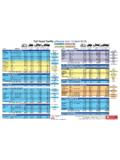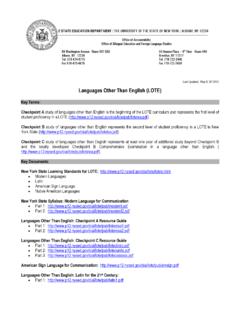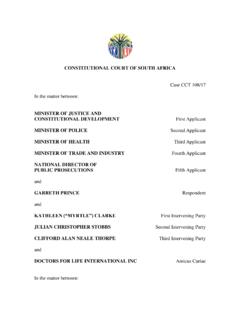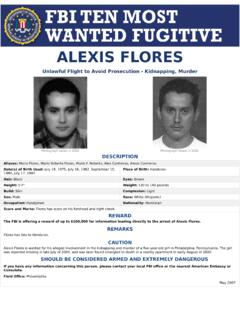Transcription of UsingTheRossNullTest - Ceravolo
1 Using The Ross Null Test By Peter Ceravolo 2003 Ceravolo Optical Systems This document may be distributed freely Introduction Measuring zones with the aid of a zonal mask, while requiring little in the way of special equipment, is decidedly not the ideal way to test a parabolic mirror at the center of curvature. Early on in my mirror making days I longed for a more accurate and easily applied testing technique which was also faster to perform. Null tests, where the spherical aberration of the mirror at the center of curvature is canceled out by auxiliary optics, are the ideal.
2 With null tests, deviations from the desired figure stand out clearly when used in conjunction with the simple Foucault test. Other, more quantitative testing techniques such as interferometry can be performed on the mirror with the aid of a null test. The Autocollimation Test Experienced telescope makers know the best method to test parabolic mirrors is the autocollimation test. The tester, Ronchi or Foucault, is placed at the focus of the mirror under test. This test usually requires a diagonal mirror, as in a typical Newtonian configuration, to keep the tester out of the light path.
3 The parabolic mirror under test collimates the beam, which is then retro-reflected back to the primary and refocused at the knife-edge. The autocollimation test is very sensitive in the detection of figure errors because the light rays bounce off the primary twice. Two reflections from bare glass also reduces the light level significantly, calling for either a darkened room or a very bright light source. The autocollimation test simulates the condition of imaging an infinitely distant source, such as a star, therefore it is suitable only for parabolic primaries, which are capable of forming a perfect image for an object at infinity.
4 The hyperbolic primary of a Ritchey- Chretien Cassegrain, or the elliptical primary of the Dall-Kirkham Cassegrain, do not form perfect images at their (the primary's) focus. These mirrors require a variable null system because the shape of the Cassegrain primary changes from system to system. However, for most hobbyists it is the expense of a large optical flat that prohibits the use of the autocollimation test. A large mirror by today's standard is 20 in diameter or greater. An optical flat for such large mirrors is out of the question for the average hobbyist.
5 2003 Ceravolo Optical Systems 1. The Dall Null Test The first null test I used, over 20 years ago while making a f/5 parabolic mirror, was the Dall null. The Dall Null test ( ) places a small, high quality plano-convex lens in front of the pinhole in a Foucault test. The light emanating from the pinhole passes through the null lens, bounces of the mirror under test to return to the knife-edge or Ronchi screen. The pinhole/null lens spacing is set to cancel out the spherical aberration of the light cone returning from the primary to the focus.
6 A. perfect mirror will gray over, or null, uniformly when a knife-edge cuts into the beam at the focus. The Dall null is a variable null test. The spacing of the pinhole and lens can be altered to accommodate a range of parabolic, hyperbolic or elliptical mirrors. As the amount of aberration goes up ( bigger, faster mirrors) so does the size of the lens required to produce an acceptable null. However, because the Dall null lens is off-axis, the size of the lens must be kept small, since a large source/return beam separation would induce a problematic amount of astigmatism.
7 When using a white light source the simple null lens will disperse the beam. The resultant chromatic aberration can be eliminated with a filter placed at a convenient point in the beam. The choice of filter must coincide with the design spacing since the spacing is wavelength dependant. A precision cell must be made to hold the pinhole and null lens at the appropriate spacing. This cell requires careful machining. Moreover, if the tester is to be used for a variety of mirrors of varying diameters and focal ratios, the cell will have to be adjustable, thus complicating its design.
8 I found the Dall null easy to use in practice, but it does have its problems when larger, fast mirrors are tested. The large separation between the pinhole and knife-edge, required in order for the return beam to clear the null lens, introduces residual astigmatism. The situation worsens as the mirror and the required null lens grows in diameter to the point where the Dall null test is inappropriate. An experienced mirror maker can learn to 2003 Ceravolo Optical Systems 2. ignore the effects of astigmatism, concentrating solely on zonal figure errors.
9 However, as the figure improves, and the residual astigmatism dominates the test result, the added noise does compromise the null, making subtle zones hard to see. The increasing magnitude of the residual astigmatism eventually renders the Dall null test unusable for large optics. While the Dall null test has its place for small, slow mirrors, there is a better refractive null test for larger mirrors. The Ross Null Test In the Ross null test a large plano convex lens, placed ahead of a conventional tester, is used to null the spherical aberration of a telescope mirror under test.
10 Unlike the Dall null, the source and return beams both pass through the Ross null lens. This in-line characteristic of the Ross test eliminates the problems caused by induced astigmatism which plagues the Dall null test. Consequently the Ross null lens can be made quite large so as to yield a high quality null for large mirrors. In fact, the only potential limitation in applying the Ross null test is that the size of the lens can get too large to be practical. The Ross null can also be applied to non-typical test situations.
